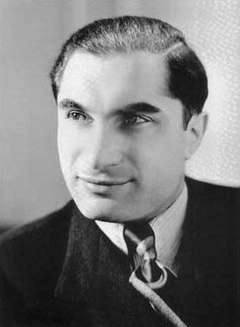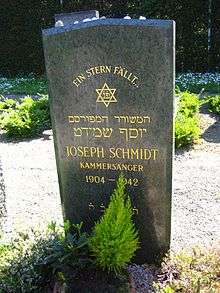Joseph Schmidt
Joseph Schmidt (March 4, 1904 – November 16, 1942) was an Austro-Hungarian and Romanian[1][2][3] Jewish tenor and actor. He was born in Davideny (Ukrainian: Davydivka) village in the Storozhynets district of the Bukovina province of Austria-Hungary, which became part of Romania after World War I and is now part of Ukraine.
.jpg)

Life and career
In addition to German, which was his first language,[4] and Yiddish, he learned Hebrew and became fluent in Romanian, French and English. His first vocal training was as a boy alto in the Czernowitz Synagogue. His talents were quickly recognised and by 1924 he was featured in his first solo recital in Czernowitz singing traditional Jewish songs and arias by Verdi, Puccini, Rossini and Bizet. Soon he moved to Berlin and took piano and singing lessons from Professor Hermann Weißenborn at the Königliche Musikschule. He returned to Romania for his military service.
In 1929, he went back to Berlin, where Cornelis Bronsgeest, a famous Dutch baritone, engaged him for a radio broadcast as Vasco da Gama in Meyerbeer's L'Africaine. This was the beginning of a successful international career. Owing to his diminutive stature (he was just over 1.5 m, or 4' 11") a stage career was impossible; however his voice was extremely well suited for radio. He made many records, first for Ultraphone, then for Odeon/Parlophone, was featured in many radio broadcasts and acted in several movies in both German and English.
Ironically, Joseph Schmidt enjoyed his greatest successes during the rise of the German Nazis, who subsequently prohibited Jewish artists and writers from working. In 1937, he toured the United States and performed in Carnegie Hall together with other prominent singers such as Grace Moore. He was still very much welcome in the Netherlands and Belgium, where he was immensely popular.
In 1939, he visited his mother in Czernowitz for the last time. When the war broke out that year he was caught in France by the German invasion. He unsuccessfully attempted to escape to Cuba. After making a dash for the Swiss border, he was interned in a Swiss refugee camp in Girenbad near Zürich in October 1942. He had already been in frail health, and was treated for a throat infection at the local hospital. Schmidt had complained of chest pains, but for some reason this was dismissed and he was discharged on November 14, 1942.
Just two days later, on November 16, 1942, while attempting to recover at the nearby Waldegg Inn, the famous singer collapsed. The hostess let him rest on her couch, but not long after, she noticed that he was no longer breathing. Schmidt had suffered a heart attack. He was only 38 years old. He was to have been issued a work permit the following day, so he would have been able to move freely within Switzerland. Joseph Schmidt is buried at Israelitischer Friedhof Unterer Friesenberg in Zürich.
A plaque is mounted at the inn where he died.
Voice and versatility
He had a sweet lyric tenor voice with an easy high register, sailing up even to a high D. His voice was also agile, and he possessed a perfect and dependable trill, which he demonstrated on his recordings of "Ah si ben mio" from Il trovatore and "Una furtiva lagrima" from L'elisir d'amore. His warm timbre was perfectly suited for the melodies of Schubert and Lehár. His popular song recordings were the best-sellers of that age. His ability to adapt to any genre or language made him famous in the Netherlands too: he did not only perform for thousands of fans in open air festivals, he sang in an impeccable Dutch, although he did not speak the language. His perfect diction is iconic and the -very Dutch- song Ik hou van Holland (translating into 'I Love Holland') was even used as the title/music score of a documentary series and a game show on Dutch television, 70 years after its first performance by Schmidt.
The most thorough discography of the tenor is that of Hansfried Sieben, published in the quarterly journal Record Collector (Chelmsford, Essex) for June 2000.
Films with Joseph Schmidt
- Der Liebesexpreß (The Love Express, 1931, Germany)
- Goethe lebt...! (1932)
- Gehetzte Menschen (1932)
- Ein Lied geht um die Welt (1933) (A Song Goes Round the World)
- My Song Goes Round the World (1934)
- When You're Young, the World Belongs to You (1934)
- A Star Fell from Heaven (1934)
- A Star Fell from Heaven (1936)
- Heut' ist der schönste Tag in meinem Leben (1936)
Recordings
- Josef Schmidt • Eterna 737. LP.[5]
- Joseph Schmidt - Sämtliche EMI-Aufnahmen - The Complete EMI recordings, Vols 1 and 2, EMI Classics, 1992. Vol. 1: CHS 7 64673 2; USA CDHB 64673. Vol. 2: CHS 7 64676 2; USA CDHB 64676. Volume 1 consists of 44 classical recordings on two CDs, while Volume 2 includes more classical recordings, and songs in German and English that Hans May wrote for the films in which Schmidt appeared, plus one in French, and another in Dutch; 39 recordings on 2 CDs.
- Joseph Schmidt Sings Concert Favorites, Decca Gold Label Series, DL 9538 (1951). Songs: Mattinata; Santa Lucia; Maria, Mari; L'Ariatella; Funiculi-Funicula; Tiritomba; Lisetta; Vienna Bonbons; Simplicius; Ich Bin Ein Zigeunerkind; Today Is the Happiest Day of My Life; A Star Falls from Heaven.
References
- http://ia700701.us.archive.org/BookReader/BookReaderImages.php?zip=/31/items/josephschmidtf001/josephschmidtf001_jp2.zip&file=josephschmidtf001_jp2/josephschmidtf001_0021.jp2&scale=4&rotate=0%5B%5D
- http://www.abc.net.au/radionational/image/2967806-4x3-700x525.jpg
- Fassbind, Alfred. Joseph Schmidt. Atlantis Musikbuch, 1992.
- Fassbind, Alfred. Joseph Schmidt. Atlantis Musikbuch, 1992.
- High fidelity: 1960 Göta, soprano (in the Puccini); Josef Schmidt, tenor; orchestra. • Eterna 737. LP. $5.95.
External links
- Joseph Schmidt Archiv in Dürnten, Switzerland
- Joseph Schmidt collection, folder 1: Personal papers and documents, professional and legal correspondence
- Joseph Schmidt collection, folder 2: Personal correspondence
- Joseph Schmidt on IMDb
- Joseph Schmidt Music and The Holocaust
- Photographs and literature
- History of the Tenor / Joseph Schmidt / Sound Clips and Narration
- Page about Joseph Schmidt on the Dutch Divas website
- Ik hou van Holland
- Concert honors singer extinguished by the Holocaust
